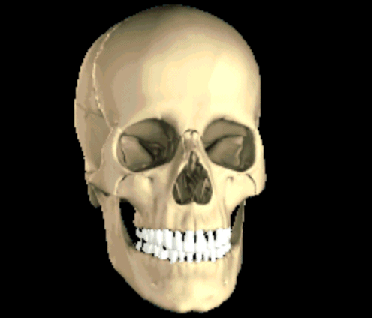The Skull
The skull is one of the principle groups of bones in the human anatomy. The skull consists of twenty-six bones: eight bones form the cranium , which houses the brain and ear ossicles , plus fourteen facial bones, which form the front of the face, jaw, nose, orbits, and the roof of the mouth, three more bones make up the inner ear ossicles, and one more, the hyoid bone, is in the neck and is attached to the temporal bone by ligaments. The bones of the skull include the frontal bone (which makes up the forehead and roof of the orbits), the occipital bone (which forms the back and base of the skull), two parietal bones (which form the roof and upper sides of the skull), and two temporal bones (which form the lower sides of the skull and house the inner ear ossicles). The lower rearmost part of each temporal bone is called the mastoid process, but because it is separated from the temporal bone, proper, by a suture, it is often considered a separate bone. The sphenoid bone forms the central base of the skull and spans the skull from side to side, the greater wings forming side plates of the skull.
The sections of the ethmoid bone are positioned between the orbits, forming the walls and roof of the nasal cavity, while the three middle ear ossicles (stapes, malleus, and incus) are located within the temporal bones on each side of the skull. The U-shaped hyoid bone is found in the neck, and is attached by ligaments to the temporal bones. In the face, the two maxillary bones form much of the orbits, nose, upper jaw and roof of the mouth, while the malar (zygomatic) bones form the cheeks. The lachrymal bones are located on the inner sides of the orbits and are attached to the ethmoid and maxillary bones. Within the nasal cavity, the vomer is located in the low center and forms the thin flat bone of the nasal septum, while two inferior urbinates form the lower sides of the cavity and two palate bones form the floor of the nasal cavity as well as the roof of the mouth. The mandible is the only movable part of the skull, forming the lower jaw and mounting the teeth.
etc
